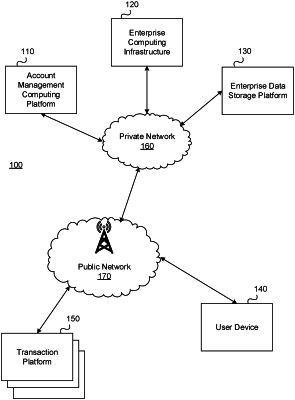| CPC G06Q 40/03 (2023.01) [G06N 5/043 (2013.01); G06N 20/00 (2019.01); G06Q 20/22 (2013.01); G06Q 20/405 (2013.01); G06Q 20/4016 (2013.01)] | 16 Claims |

|
1. A computing platform, comprising:
at least one processor; and
memory storing computer-readable instructions that, when executed by the at least one processor, cause the computing platform to:
receive historical user activity data of a plurality of users;
identify, from the historical user activity data, one or more attributes of the plurality of users;
train a first machine learning model to determine patterns of user activity by using the one or more attributes as inputs in a clustering algorithm to classify the plurality of users based on the attributes;
receive user activity data of a first user;
determine, by executing the first machine learning model and based on the received user activity data of the first user, a pattern of first user activity;
detect a deviation from the pattern of the first user activity;
identify an anticipated transaction of the first user;
train, using the historical user activity data, an intelligent virtual assistant based on a second machine learning model, wherein training the intelligent virtual assistant causes the intelligent virtual assistant to, receive inputs including user response data, and, when executed, analyze the user response data, determine outputs available and tailor the outputs to provide to the user based on the determined pattern of the first user activity, wherein the intelligent virtual assistant is integrated with one or more external artificial intelligence systems;
determine one or more user-defined preference rules of the user, wherein determining the one or more user-defined preference rules includes:
execute the intelligent virtual assistant to initiate an interactive session between the intelligent virtual assistant and the first user;
receive user input related to the one or more user-defined preference rules;
analyze, using natural language processing and by traversing a hierarchical tree structure, the user input to identify the one or more user-defined preferences; and
store, based on the analyzed user input, the one or more user-defined preference rules in a repository of user data;
retrieve, from the repository of user data, the one or more user-defined preference rules associated with the anticipated transaction;
determine whether the one or more preference rules apply to one or more attributes of the anticipated transaction, wherein determining whether one or more preference rules apply to the one or more attributes of the anticipated transaction include:
determining whether the user is able to connect to the internet;
responsive to determining that the user is able to connect to the internet, providing communications to the user via a first mode of communication;
responsive to determining that the user is not able to connect to the internet, providing communications to the user via a second, different mode of communication; and
trigger, based on a determination that the one or more preference rules apply to the one or more attributes of the anticipated transaction, an action associated with the anticipated transaction, wherein triggering the action includes at least providing communications to the user via one of: the first mode of communication and the second mode of communication.
|